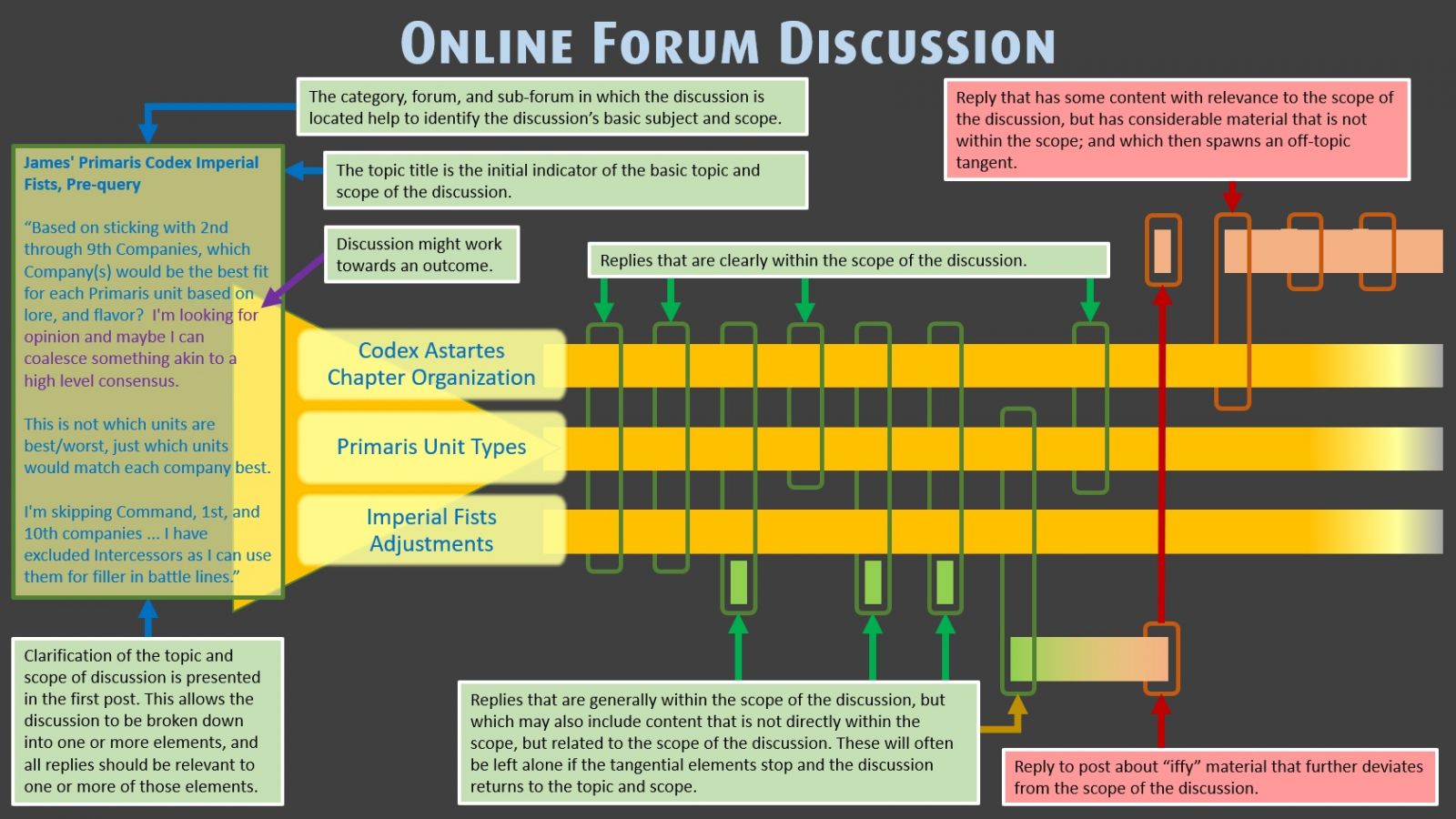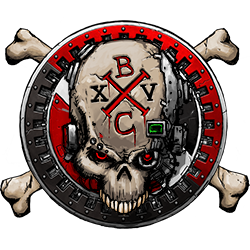Content Architecture at the Bolter & Chainsword (an editorial of sorts)
The purpose of this article/editorial is to provide some insight into the concepts and methodologies employed by the staff in enforcing the site’s on/off topic rules.
A few terms are used within this article/editorial:
Information architecture (IA) focuses on organizing, structuring, and labeling content in an effective and sustainable way. The goal is to help users find information and complete tasks. Instead of “information architecture” the term “content architecture” will be used in this article as we are referring not just to information, but to the full range of content that can be found here at the Bolter & Chainsword, including images in the galleries, files in the downloads, etc.
Findability is the ease with which information contained on a website can be found, both from outside the website (using search engines and the like) and by users already on the website.
Off-topic means that a topic brought up in a discussion isn’t directly related to the discussion’s topic. It might be valid for discussion within the scope of the Bolter & Chainsword’s subject matter, but it is either unrelated to or only tangentially related to the discussion topic.
A complaint occasionally voiced here at the Bolter & Chainsword is that the rules of the site stifle discussion, that discussions should be allowed to evolve naturally. Here’s the rub, though: a discussion taking place at an online discussion forum isn’t a “natural” discussion, nor should it be. Treating an online discussion as a natural discussion actually degrades discussion. To understand why this is true, you need to understand the two mediums (natural discussion and online discussion) and how they are vastly different.
A “natural” discussion is when two or more individuals engage in a discussion in the present. All participants may be in the same physical location and engaged in verbal discussion, using sign language, gestures, or other mediums; or they may be separated and communicating via electronic means such as telephone, video conference, or other means. The key with a natural discussion is that the discussion is conducted in real time in the present. The composition of the participants can change over the course of the discussion, with members leaving and others joining, and the discussion can continue to develop naturally, with participants responding to each other. The topic will typically change throughout the course of the discussion regardless of how the discussion started. The discussion may have started on the topic of last night’s sporting event, evolving into an article of clothing someone wore at the event, then shifting to favorite colors, then shifting to sports cars, and so on; each evolution in the topic deriving from what individuals think about as the discussion progresses. In a “natural” discussion it is even possible for a topic to shift abruptly without any real transition or linkage between one topic and the next. Individuals joining the discussion as it evolves are not concerned with what was being discussed three topics ago – they simply join the discussion as the current topic is discussed. In a “natural” discussion, topics are ephemeral and awareness of the points made for previous topics addressed in the discussion isn’t always necessary for effective participation in discussion of the current topic. Notably, the average human being can only participate in one “natural” discussion at a time.

Fig. 1 ”Natural” discussion progression
In an online discussion, participants take part in a primarily text-based exchange of ideas. Although these exchanges are often punctuated with graphics (emoticons/emojis/memes), videos, and sound, the true “discussion” is built around the text. Online discussions are conducted in an asynchronous manner and discussions may take place over the span of hours, days, months, or even years, with varying gaps in time between posts. An online discussion is effectively permanent, lasting as long as the discussion remains visible and allowing for participation in perpetuity. It is possible for an online discussion started in 2005 by a certain group of participants to resume in 2025 with a completely different set of participants, the participants able to review the entirety of the early discussion and carrying on by providing their own relevant input. Where a “natural” discussion’s topic is defined by what is being discussed right now, an online discussion’s topic is defined by how it is placed in the content architecture, the topic title, and the parameters given in the first post (and occasionally as adjusted within the first few posts). The capabilities of online discussion forums also allow for linkages between different discussions, enabling participants to explore different related topics without derailing a discussion through the simple expedient of starting a new topic and linking between the original and new topics. It is also very important to realize that members can participate in multiple online forum discussions concurrently.

Fig. 2 Online discussion progression, including off-topic tangents
Instead of being a natural discussion, an online discussion is more like a classroom, debate, seminar, or convention session in certain respects. In each of these environments, the basic subject matter is pre-determined and there is a basic agenda. Typically, while there are many people present in each of these environments, active participants represent a small fraction of those that are taking part in the overall effort – most people are simply taking the discussion in without contributing. While discussion occasionally veers off into tangents, those that are in control must bring the discussion back on topic if the overall effort is to be successful. Sometimes, too, a specific point is relevant, but it requires an in-depth exploration that might detract from the broader issues. Sometimes these points can be resolved quickly. At other times, however, they might involve a lengthy discussion. In such cases, it might be prudent to resolve them separately so that the larger discussion can continue. Side discussions that are brought up may be worthy of discussion, but they should either be saved for later or taken outside so that the main discussion isn’t disrupted. People attend the event because they are interested in topic X and there is a good chance that they will be dissatisfied and/or leave if the discussion instead becomes about topic Y. Remaining on topic in these environments is central to successful discussions.
An online discussion’s topic is generally defined through three elements: placement in the overall structure (category, forum, sub-forum), the topic title, and the first post.
The first level of organization in our discussion content architecture is the forum categories. These are somewhat broad and are currently:
- Community (general topics)
- Forge (the modeling and painting aspects of the hobby)
- Imperium
- Chaos
- Xenos
- Strategium
- The Horus Heresy
- In the Grim Darkness of the Far Future (other WH40K hobby entertainment)
- Fan-Made (areas where fans can exercise their WH40K hobby creativity)
- Ordo Administratum (resources for using the site rather than participating in the hobby)
Hopefully, we’ve organized and named these categories in a way that makes it easy for members to understand what each category is about in order to find the content that they want while bypassing/ignoring the content that they are not interested in. Members are able to hide any categories in which they have no interest (including all forums and sub-forums within) by a simple click of the mouse, making the chore of navigating to the forums in which they participate quicker and easier.
The second level of organization in our discussion content architecture is the forums and sub-forums. These, too, are (hopefully) organized in a logical manner. In most cases, forums are organized in alphabetical order, but there are some where another construct is used. An example of this is the Forge whose forums are organized in a slightly different manner. As a general rule, our faction-based forums are structured around codices and codex supplements, with each codex having a forum and all of its related codex supplements being included as sub-forums beneath that forum (there are a few exceptions, notably the Adeptus Astartes and Heretic Astartes forums and sub-forums). This structure allows for varying degrees of specificity. For example, a discussion on the general merits of [Codex: Space Marines] Assault Intercessors would take place in the Adeptus Astartes forum, whereas a discussion about using Assault Intercessors in the context of the Imperial Fists Chapter (presumably in coordination with the rules and units specific to the Imperial Fists codex supplement) would take place in the Imperial Fists sub-forum. Similarly, topics that are common to two or more (sub-)factions would take place in the higher level (sub-)forum. In most cases it is easy to identify the appropriate (sub-)forum for such a discussion, but there are few cases where it is not as obvious. For example, the loyalist Imperial Knights and traitor Chaos Knights are discussed in different forums within different categories, but there are many elements that they have in common; those common elements should be discussed where the Imperial Knights are discussed. This principle similarly applies to those elements that the Heretic Astartes have in common with their loyalist brethren, with topics about common elements taking place in the Adeptus Astartes forum.
The category/forum/sub-forum placement allow for placement of a topic where it is most applicable. This compartmentalization reduces the “noise” that members have to filter through in order to focus on the topics that are of interest to them. For example, a hobbyist that is focused on Orks and who has no interest in discussing the Dark Angels can find the Ork discussions through the simple expedient of going to the Orks forum within the Xenos category, bypassing all of the Dark Angels discussions by skipping over the Dark Angels forum within the Adeptus Astartes category.
One of the most important principles of the category/forum/sub-forum structure is that it is built around content and not audience. A common mistake that members make is posting a topic in the incorrect (sub-)forum. This is often done deliberately in order to reach a certain audience. While this may sound reasonable, it degrades the topic’s findability and limits participation in the discussion. When trying to ensure that a particular segment of the community has awareness of a discussion, the proper course of action is to provide a link, either via a discussion topic in that community (sub-)forum or within your signature. Topics will be moved to the appropriate (sub-)forum based on their content.
The next element in defining a topic, and arguably the most important for getting other members’ attention, is the topic title. This is the first thing that catches a member’s eye, providing basic information on what the topic is about. A well-crafted topic title allows other members to assess at a glance whether or not a discussion is worth opening, and it lays the groundwork for identifying the basic scope of the topic. A poorly crafted topic title tells other members very little about the discussion’s scope, forcing them to decide between just moving on (and potentially ignoring a topic in which they might have interest) or clicking on the topic (and potentially finding out that the topic is of no interest to them). For example, over the years there have been dozens of topics titled “Legion of the Damned” here. While that title might be sufficient in the Forge forums where it is obvious that there will be pictures of Legion of the Damned models, it is woefully inadequate in the discussion-based forums. A discussion about the various origin theories of the Legion of the Damned might be given the title of “Legion of the Damned Origin Theories” whereas one about different types of units in the Legion of the Damned might be given the title of “Legion of the Damned Units.” Topic titles are limited to 90 characters, however, so they can give only a basic level of specificity. Ultimately, they should be thought of as basic summaries of the discussion’s subject matter and scope.
The full definition of a discussion’s subject matter and scope is usually provided in the first post. Occasionally, the first post might be a bit vague or it might be created without a solid idea of its intended topic, in which case the topic will be better defined later. This refinement of the topic generally takes place on the first page, most often within the first half dozen posts. Subject matter and scope are rarely provided in a legalistic manner where the limits of what might be considered “on topic” are clearly defined. Instead, the discussion’s subject matter and scope are defined by implication, and this can often be open to interpretation. If you have to play six degrees of separation to figure out how a reply is relevant to the topic, however, the reply is off topic. At most, a reply should only have one degree of separation from the discussion topic, and the content of the post should be in the context of how it relates to the discussion topic. Once replies are two degrees of separation or more away from the discussion’s actual topic, or they begin to focus on the separated topic and not the discussion’s topic, they should be taken up as separate discussions (and sometimes in entirely different forums). A little bit of drift is allowed, but the discussion should quickly return to its topic.
An excellent illustration of these principles can be found in the Aeldari forums:
- A member started the Karandras possibly created Drazhar? discussion. Naturally, the topic revolved around the origins of the Drukhari character Drazhar. Relevant topic elements included the Phoenix Lord Karandras, his predecessor Ahra, the Striking Scorpions Aspect of the Asuryani, and the Incubi, but each of these was only relevant with regard to how they relate to Drazhar’s origins (see the bottom bullet below).
- In that discussion, another member posed comments that steered exploring the broader issue of the origins of the Phoenix Lords. That post was split off into its own topic to discuss the issue of how Phoenix Lords are made. To illustrate how topics can last for years, that topic started in March of 2020 and died down later that month, but was picked back up in November of 2022.
- The discussion about how Phoenix Lords are made prompted another line of thought that was taken up in an entirely new discussion to explore whether or not hobbyists thought that other types of “Phoenix Lords” (or Aeldari with similar death/rebirth cycles) were possible. Instead of being focused on the Phoenix Lords of the Aspect Warrior shrines, this discussion considered whether or not the Aeldari might have other types of immortals.
- That discussion prompted another line of discussion about additional aspect warrior shrines, taken up in this discussion. The most well-known shrines are those that are common to all of the major craftworlds and which are present in the rules and models. This discussion explored other shrines that have been mentioned in the lore, whether in the rulebooks or novels, as well as speculation about other types of shrines that might be possible.
- Anyone wishing to explore the other elements (Karandras, Ahra, the Striking Scorpion Aspect of the Asuryani, the Incubi, etc.) in more detail (i.e., outside the scope of Karandras possibly creating Drazhar) would need to start a separate discussion.
Had the off-topic elements not been split into a separate topic and the other tangential thoughts been taken up in the original discussion instead of in their own topic, the original topic would have become a mess. Someone might come into the topic expecting to see discussion about Drazhar/Ahra/Karandras, but might have found posts about minor Aspect Warrior Shrines instead. This would have been very confusing. By keeping the discrete topics separated while cross-linking them, different but related ideas were split up and discussions could remain focused on the specific topics. It takes very little time and effort to do this and shows respect for other members.
Ultimately, discussions that take place in an online discussion forum are not some sort of race. While it is very easy to post a reply about something that you think of while participating in a discussion, if that subject matter isn’t directly related to the topic at hand, it can create confusion for other members. Creating a separate discussion about that subject matter is preferred, allowing each discussion to focus on its intended subject matter. As the example above shows, you can also link between topics to help steer people towards related discussions without muddying the waters of either.
Overall, remaining on topic in a discussion improves findability of information, especially when members are searching for topics via the discussion list (rather than using the search function). Members are able to quickly assess discussion topics via their content architecture: category, (sub-)forum, and topic title instead of being caught off guard by finding something that is off topic in a discussion (e.g., a series of posts about Imperial Fists and their scrimshandering in a discussion about the Salamanders and their branding practices). While many members don’t make a habit of reading through old discussions, there are many members that do take advantage of this site capability, especially when they want to revisit a discussion. In this, the findability of information is very important.
The staff members have several options when they find off-topic posts. The first is to leave them alone, and this might happen if the issues are minor and don’t appear to disrupt the overall conversation. The second is to split related off topic posts into a separate discussion, sometimes moving that discussion into another (sub-)forum altogether. This might happen if there is a constructive discussion among the off-topic posts and if the staff members have the time and interest. The third option is to hide the off-topic posts. Regardless of the option chosen, the staff members may or may not remind members to remain on topic, and they may re-state the topic for clarity. Far from being “censorship” or “restrictive,” these measures are intended to make the best use of the online discussion forum’s capabilities, giving members a clear idea of what any discussion is about and keeping findability of information as high as possible.
Admittedly, whether or not a post is on/off-topic can be subjective. The basic litmus test is whether or not someone reading the topic title should expect to find a post about X in that discussion. Sometimes a bit of wiggle room can be found, especially if the discussion winds its way back to the established topic. At other times the answer is very clear.



0 Comments
Recommended Comments
There are no comments to display.
Create an account or sign in to comment
You need to be a member in order to leave a comment
Create an account
Sign up for a new account in our community. It's easy!
Register a new accountSign in
Already have an account? Sign in here.
Sign In Now